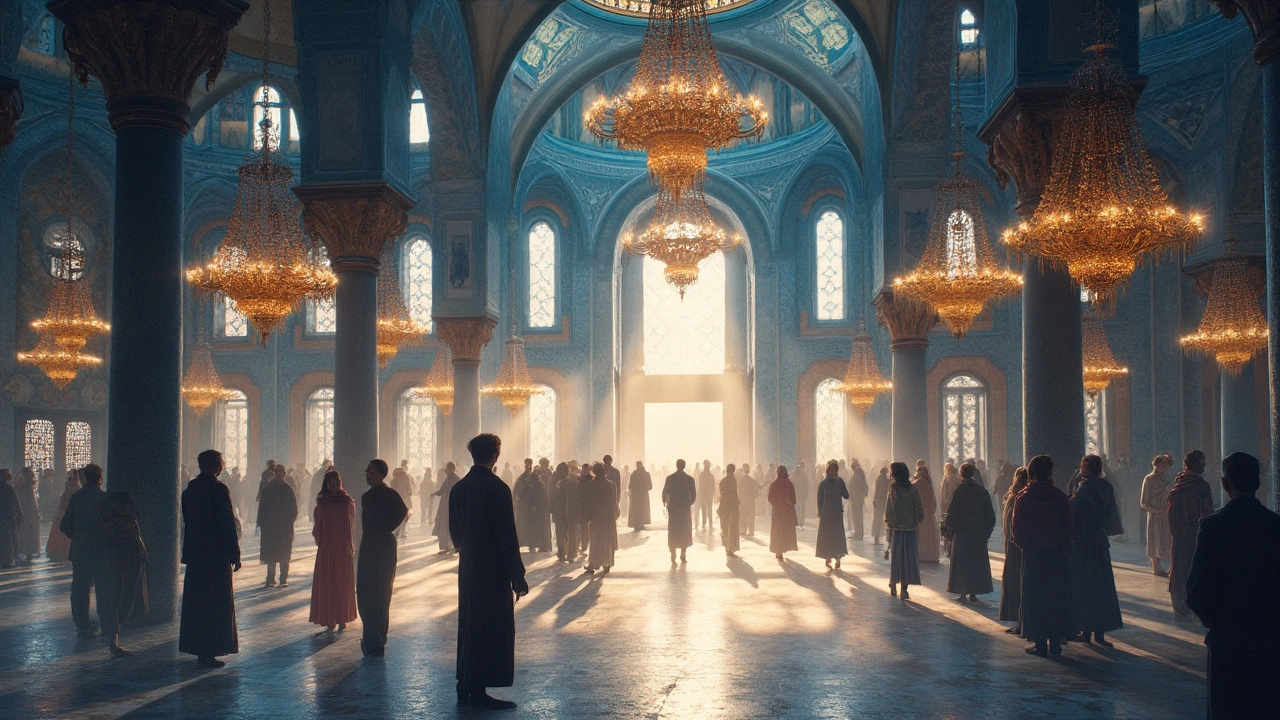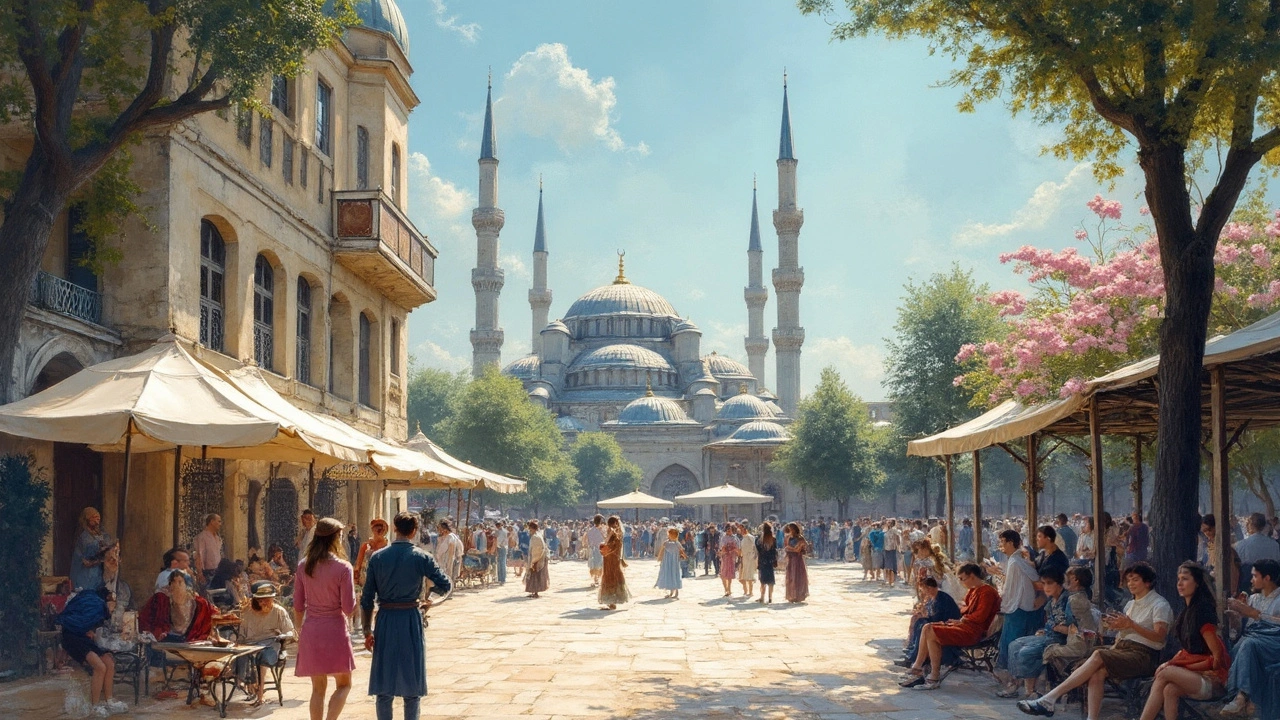The Blue Mosque: Where History and Spirituality Meet

So you’re wandering through Istanbul, taking in the sights, and someone whispers, “Ever seen a mosque that leaves you speechless?” They’re talking about the Blue Mosque, a masterpiece draped in history and drenched in spirituality. This isn't just a sight for sore eyes; it's a place that gets to the soul.
First thing you’ll notice is the jaw-dropping architecture. The Blue Mosque, or Sultan Ahmed Mosque if you’re feeling formal, stands out with its cascading domes and soaring minarets. But the real magic happens inside, where more than 20,000 hand-painted ceramic tiles in tulip designs make up the iconic blue interior. It’s more than just a visual feast; it's a journey back to the 1600s when this place was the linchpin of the Ottoman Empire.
This isn’t your regular tourist trap—it’s a working mosque. Picture this: the muezzin’s call to prayer echoing across the courtyard, blending history with living spirituality. To make the most of your visit, respect the prayer times and bring a scarf if you're a woman visitor. It's all about enjoying the blend of historical awe and religious reverence.
- An Architectural Marvel
- The Spiritual Atmosphere
- Visiting Tips and Etiquette
- Cultural Significance
- Planning Your Visit
An Architectural Marvel
Welcome to the jaw-dropping world of the Blue Mosque. This isn't just any mosque; it’s an Ottoman masterpiece with a little magic thrown into every brick and dome. Sitting across from the Hagia Sophia in Istanbul's Sultanahmet district, the mosque is a stunning sight that makes you stop and stare.
Construction kicked off in 1609 under the watchful eye of Sultan Ahmed I, and it wrapped up in 1616. Designed by architect Sedefkar Mehmed Agha, a student of the famous Sinan the Architect, this mosque blends Byzantine and Islamic influences perfectly. The exterior is known for its six striking minarets, which was a bold move at the time—until then, only the Grand Mosque in Mecca could boast that many.
Step inside, and you’re greeted by an ocean of over 20,000 handmade Iznik tiles, mostly blue, that give the mosque its name. These aren’t just any tiles—they come in more than fifty different tulip designs. During the day, sunlight streams through more than 200 stained glass windows, casting colors that shift and dance around you. It’s a vibrant play of light and art that leaves visitors in awe.
The Dome That Dazzles
The central dome of the Blue Mosque soars to a height of 43 meters. It's supported by four enormous pillars known as 'elephant feet,' and surrounded by smaller domes and semi-domes, creating a cascading effect. The clever use of space and perspective makes the interior feel both grand and intimate.
Craftsmanship That Tells a Story
Every inch inside the Blue Mosque shows off the finest Ottoman craftsmanship. The calligraphy that adorns the walls? Done by Seyyid Kasim Gubari, one of the top notch calligraphers of his time. The chandeliers, originally filled with ostrich eggs to drive away spiders, now sparkle with modern lights. It's these little details that give the mosque its timeless charm.
Fun fact: Did you know the mosque was initially criticized for having six minarets, the same as the Kaaba in Mecca? Sultan Ahmed quickly diffused the situation by funding the construction of a seventh minaret in Mecca.
The Spiritual Atmosphere
Stepping inside the Blue Mosque is like walking into a piece of living history. There's no other way to describe the atmosphere but powerful and serene, all at once. It's not just the grand architecture that whispers tales of the past, but the air itself seems to hum with spirituality.
Here’s the kicker—the mosque is a functioning place of worship, so expect to see locals dropping by for prayers. Around five times a day, the call to prayer fills the air, echoing through the grand corridors. It's an experience that grounds you, making sure the hustle and bustle outside is left at the door.
Understanding the Traditions
Visitors are more than welcome, but there are a few house rules out of respect. During prayer times, you’ll only be admitted outside the main halls, but if you time it well, there’s plenty to see and do. Remember to dress modestly; long trousers or skirts for everyone and headscarves for women are the way to go. You don’t want to make any unwitting fashion statements that might raise eyebrows.
The mosque isn’t just about rules though, it’s about immersion. Take a moment to sit in one of the courtyard's corners and just listen. You’ll find a sort of peace that’s hard to come by in the city’s more tourist-heavy spots. It’s spiritual, sure, but it’s also a good reminder of how people from all walks of life find a moment of stillness here.
Special Times to Visit
If you're looking to capture that perfect Insta shot, try visiting in the early morning or just before sunset. The light through the blue tiles is something else, creating a meditative atmosphere that's pure magic. While afternoons are more crowded, sometimes it's worth it just to see the blend of tourists and worshippers coexisting in such a storied space.
There’s no entrance fee, but donations are appreciated. It feels good walking away knowing you’ve contributed to the upkeep of such a breathtaking piece of history.

Visiting Tips and Etiquette
Visiting the Blue Mosque is an unforgettable experience, but there are a few things you should know to make the most of your trip while respecting the local customs. Here’s the lowdown on how to navigate your visit smoothly.
Proper Dress Code
The mosque is a place of worship, so dressing modestly is key. Men should avoid wearing shorts or sleeveless shirts, while women should cover their heads with a scarf and wear long skirts or pants. If you forget, don’t sweat it—the mosque offers robes and scarves at the entrance.
Timing is Everything
The Blue Mosque is open daily, but it's closed to non-worshippers during prayer times. Services occur five times a day, so check the local prayer schedule to avoid disappointment. Mornings are typically less crowded, making it the best time to visit if you're looking for a peaceful experience.
Photography and Behavior
- Photography is allowed, but using a flash or taking pictures of people during prayer is a no-go.
- Keep noise to a minimum. It’s a place for quiet reflection, not a chatty hangout.
Support the Maintenance
Entry is free, but donations are welcomed and put toward the mosque’s upkeep. Consider chipping in if you can. Every bit helps to preserve this grand structure.
Respect the Space
Upon entering, remove your shoes and place them in provided plastic bags or shelving. Keeping the mosque clean and respected is part of the cultural etiquette here.
With these tips in hand, you're set to explore one of Istanbul's most treasured landmarks. By following these simple guidelines, you'll not only have an amazing visit but also show respect to the locals and their customs.
Cultural Significance
The Blue Mosque isn’t just an architectural show-stopper; it’s a cultural icon that’s as deeply woven into the fabric of Istanbul as kebabs and Turkish tea. Built during the reign of Sultan Ahmed I, this mosque was more than a place for prayers—it was a symbol of imperial power and a stunning example of classical Ottoman style, which sought to rival the majestic Hagia Sophia just across the square.
The mosque's location in Istanbul is no accident either. It was positioned strategically where the Byzantine Palace once stood, signifying the Ottoman’s mighty presence and architectural prowess. For those who love numbers, it boasts six minarets, aligning it with the Prophet’s mosque in Mecca, which was a bit controversial back in the day.
Beyond its religious duties, the mosque has been a center of cultural exchange. Over the centuries, it has drawn scholars, architects, and tourists fascinated by its design and historical significance. Events and gatherings here have long echoed the lively and diverse spirit of Istanbul.
Influence Beyond Borders
The impact of the Blue Mosque stretches far beyond Turkey. Its iconic name and character have inspired numerous constructions in other parts of the world. If you ever find yourself in places like Cairo or even Kuala Lumpur, you might notice the echoes of its grandeur in local mosque designs. The Blue Mosque is like that seasoned traveler who leaves a little bit of himself wherever he goes.
It also plays a role in interfaith dialogues, often hosting visitors from various religious backgrounds, fostering understanding and appreciation across cultures. It's not just bricks and tiles; it's a bridge between past and present, east and west.

Planning Your Visit
Getting the lowdown on how to plan your time at the Blue Mosque is key to having a smooth visit. First off, know when to go. The mosque is open every day, but it's closed to tourists during prayer times, which happen five times a day. So, aim for mid-morning or early afternoon visits—it’ll save you heaps of waiting time.
Getting In
No need to shell out any cash to enter the mosque—tourist entry is totally free. But a heads-up: donations are appreciated. You’ll find donation boxes inside, so feel free to drop a few lira to help with maintenance work.
Dressing the Part
Dress code is important here. Everyone should dress modestly—think covered shoulders and knees. Ladies, pack a scarf for your head. If you forget, no worries; they hand out wraps at the entrance.
Best Days to Visit
Weekends can get crowded, so hit it up on a weekday if you can. Plus, early birds avoid the rush, getting a quieter, almost private experience. It's like having your own slice of history.
A Quick Checklist
- Check prayer times, so you're not waiting around.
- Wear appropriate attire or borrow wraps at the entrance.
- Carry a camera; photography is allowed in most areas.
- Explore nearby spots like the Hagia Sophia for a full day out.
And here's a stat for the road: more than 5 million people visit the Blue Mosque each year. Join them, and you'll see why it's one of Istanbul’s top picks!